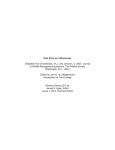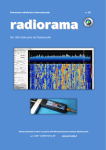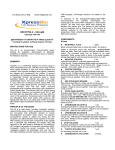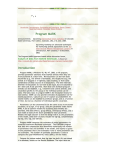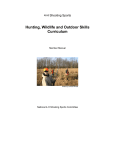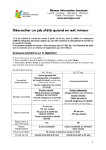Download Population Analyses
Transcript
Population Analysis, Fall 2005 1 Population Analyses EEOB/AEcl 611 Fall Semester 2005 Scheduled meetings: MW 12 Room 231E Bessey, T 11-1 Room 231E Bessey INSTRUCTOR: Dr. Bill Clark Office: 233 Bessey Phone: 294-5176 email: [email protected] AEcl 611 is evolving in response to very rapid changes in the field of population analyses, changes in quantitative ecology courses at Iowa State, and changes in student backgrounds and needs. The overall objective of the course is to integrate estimation of parameters such as population density and survival rate with important questions in population ecology. The emphasis in AEcl 611 is on understanding the statistical basis of various analytical techniques, applying techniques to data on taxa including insects, plants, and all kinds of vertebrates, and developing proficiency with current software like MARK, PopTools, and MATLAB. PREREQUISITES: The catalog prerequites for AEcl 611 are AEcl 312 (Ecology), Stat 401 (Stat for Research), and a course in calculus. You will be expected to understand concepts of statistical inference, to be able to execute a regression, c2 and Z tests, and to use minimal concepts from calculus. We will make substantial use of software on PC’s, including MARK, SAS, DISTANCE, and others. We’ll often use the “recitation session” to get you started with homework problems and software. There is an emphasis on “learning by doing” through the homework problems. REQUIRED TEXT There is now a great text that covers the material in 611 and beyond: Williams, B. K., J. D. Nichols, and M. J. Conroy. 2002. Analysis and management of animal populations. Academic Press (~ $99, this book is "one stop shopping for population analyses"). I strongly recommend that you purchase this book. I will also make available the pdf version of the manual: Program MARK: a gentle introduction (Evan Cooch and Gary White Population Analysis, Fall 2005 2 2001) that can also be downloaded from Evan’s web site (http://www.phidot.org/software/mark/docs/book/). It includes some of the conceptual material that we will cover as well as the practical applications of using the MARK software. There will be many assigned readings from texts, other manuals, and the primary literature. We will plan the relative emphasis on the topics below as we see where our interests take us. TOPIC OUTLINE: APPROX. DATES I. Introduction to population analysis A. Population dynamics, birth and death, rates of growth, and trends B. What are you interested in? Aug 22 II. Statistical concepts and tools Aug 23-31 A. Sampling, estimation of parameters, and modeling B. Precision, bias, confidence intervals C. Sampling and “process” error D. Power, effect size D. Maximum likelihood and information criteria Labor Day Holiday Sep 5 III. Mark, release, recapture, recovery methods A. Estimating population size of Closed Populations 1. Binomial sampling, multinomial models Sep 2. Otis et al. 1978 CAPTURE & MARK 3. Indices and Minimum N alive B. Open populations, estimation of N 1. Intro Jolly/Seber, Pollock et al. 1990 Sep JOLLY, JOLLYAGE Clark gone to TWS Sep f C. Estimating survival, 1. Jolly and survival Oct 2. Live recaptures--Cormack/Jolly/Seber Lebreton et al. 1991 (JOLLY, MARK) D. Extensions of CJS framework with MARK 1. Using MARK: PIM’s and Design Matrices Oct 2. Adding explanatory covariates 3. Estimating movements (separating f into S and y (Hestbeck et al.) 4. Estimating recruitment and rates of growth (l)(Pradel et al.) Oct 6-12 13-21 26-28 3-12 17-19 Oct 24 Oct 25 26-31 Population Analysis, Fall 2005 3 5. Robust design—combining closed and open models Nov 1-2 6. Dead recoveries (Brownie et al. 1978) Nov 7-8 MARK (ESTIMATE, BROWNIE) 7. Resighting, combining live and dead (Barker’s models) IV. Observations of failure times, resampling methods estimating survival, S or f A. Nest success models Mayfield 1961, MARK B. Failure time methods, Kaplan/Meier STAGGER, SAS, MARK C. Proportional hazards applications Thanksgiving holiday week VI. Distance sighting methods A. Line transects – Buckland et al. 1992 DISTANCE Nov 9-16 Nov 21-25 Nov 28-30 VII. Loose ends Dec 5-7 23rd annual course evaluations! Dec 15 COURSE GRADING: Mid-term Exam - 30% (approximately mid-term) Final Exam - 30% (finals week, including orals) Homework - 30% (approximately one assignment per week) Class discussion – 10% Population Analysis, Fall 2005 4 Homework 0 1. y = 2x2: 2. y = (1-2x)(3-x): 3. y = (3x-5)/(2x+7): 4. y = ex: 5. y = aebx: 6. y = ln(x): 7. y = ln(1-x): 8. ln(x*y) = 9. ln(x/y) = 10. ln(xp) = 11. f(N) = dN/dt = 0.015(N) + 2 Plot f(N), find and plot f'(N) 12. N t = N0e rt: 13. W = a(1-e-bt): Plot y(x) and find dy/dx Find dy/dx Find dy/dx Find dy/dx Find dy/dx, plot y(x) and dy/dx for a=1 and b=0.25 Find dy/dx Find dy/dx Find dN/dt if N=N0 at t=0 Find dW/da, dW/db, and dW/dt 14. Nt = K 1 + be- rt Find dN/dt 15. Ú dx = x 16. Ú dx = (1 - x) Population Analysis, Fall 2005 5 Population Analysis, Fall 2005 6 Homework 1 1. For a review of statistical concepts related to estimation and mark-recapture complete problems 4, 5, 6, 8, 9, 10, 11, 12, 13, 14, 15, 16, 19, 20, and 22 at the end of Chapter 2 in White et al. 2. To follow up on Dave Otis’ example of the multinomial extension of the simple binomial probability distribution consider the same case of a three-capture survey. On occasion 1 we mark and release n = 100 individuals, and then recapture them on occasions 2 and 3. The possible recapture histories are X00, X10, X01, X11. Assuming that the recapture probability is different on occasions 2 and 3 (i.e. p2, p3) write the expressions for the probability of each outcome (i.e. P[X00], etc.) and then write the expression for the set of all outcomes (the likelihood function). Suppose that we have some prior experience capturing these animals and we think that p2 = 0.20 and p3 = 0.10. For each capture survey case below calculate the value of the likelihood for the two sets of observations below: X 00 X 10 X 01 X 11 Case 1 Case 2 80 12 4 4 40 40 10 10 For which case are the values of p2 and p3 that we picked more “likely” given these two sets of observations? Can you roughly estimate the likely values of the parameters from the observations? Population Analysis, Fall 2005 7 Homework 2 1. Attached is an X matrix from a recapture study of fox squirrels. The first part of your assignment is to estimate population size using the most recent version of CAPTURE99 (see Rexstad and Burnham 1991). I generally find it easiest to run from the MSDOS prompt and store my files and work in a directory like C:\Capture99 (I’ve stored the data that way on the PC’s in Room 106). You can use MARK to analyze these data, but I suggest that you start with CAPTURE because model selection and estimation is more straightforward. As with most software, CAPTURE and MARK are particular about the input file. I have included an electronic version of the fox squirrel data in the Capture99 directory called CAPTIN.fox. Notice the structure of the X-matrix format of the data and the format of the input line. The first two characters are the animal ID, then skip a space, then repeat the X matrix captures (1=captured) for 10 occasions. DATA='X MATRIX' FORMAT='(A2,1X,10(F1.0,1X))' READ INPUT DATA 1 1 0 0 1 0 1 1 1 1 0 2 1 1 1 1 1 0 1 1 0 1 3 1 1 1 1 1 1 1 1 1 1 Constructing input in X Matrix format is good practice for MARK although MARK requires that you comment out the ID, use no spaces within the X Matrix, and include a group number and ; at the end of each line. In later exercises you will input data in a more convenient form called NON XY, rather than the fully specified X matrix. See Rexstad and Burnham or Appendix A of White et al. for an explanation of Non XY as a way to organize your data. For practice make a file in both X Matrix and Non XY formats to hand in as part of this homework. Now run CAPTURE by Start – Programs – MSDOS Prompt. Change to the C:\Capture99 directory. Then at the prompt type CAPTURE i=your input file o=your output file. Consider CLOSURE, MODEL SELECTION, and POPULATION ESTIMATION. Interpret the results. Was the survey adequate to obtain a reasonable estimate of N, considering bias, precision, and robustness of the model selected? 2. Next go on to see how well you understand underlying model structure by rerunning these same analyses with MARK. I’ll give you a quick lesson on starting MARK and show you the parameter information matrix (PIM) that will work for M(0). In M(0) there Population Analysis, Fall 2005 8 is one nuisance parameter p and N that you’ll estimate. But MARK includes a parameter for recapture(c) to enable you to model behavior and hetereogeneity. You should recognize that when there is no time or behavioral response p = c for all times. So the PIM’s for M(0) look like PIM for p capture probability 1 1 1 1 1 1 1 1 1 1 PIM for c recapture probability 1 1 1 1 1 1 1 1 1 PIM for N 2 Write a couple of sentences explaining how the above PIM’s reflect the model M(0). Run the model and see how the results compare them with CAPTURE. Now construct PIM’s for the Darroch model M(t) and Zippin model M(b) and run those in MARK. Interpret the model selection for these 3 models and compare the estimates and confidence limits obtained from MARK with those obtained from CAPTURE. CAPTURE-RECAPTURE OF FOX SQUIRRELS ID 1 2 3 4 5 6 7 8 9 10 11 12 13 14 15 16 17 18 19 20 21 22 23 24 25 'X MATRIX 1 0 0 1 0 1 1 1 1 1 1 1 1 1 1 1 1 1 1 1 1 1 1 0 1 1 1 1 1 1 1 1 1 0 1 1 1 0 1 1 0 1 1 0 0 0 1 0 0 1 0 1 0 0 0 0 1 0 1 1 0 1 0 0 0 0 1 1 0 1 0 0 1 0 1 0 0 1 0 1 0 0 1 0 0 0 0 1 1 1 0 0 1 1 1 0 0 1 0 0 0 0 1 1 1 0 0 1 0 0 0 0 0 1 1 0 0 0 1 1 0 0 0 1 0 1 0 1 1 1 1 1 1 1 1 1 0 0 1 0 0 1 1 1 0 0 0 1 1 0 1 1 1 1 1 1 1 1 0 1 1 0 0 1 0 1 0 1 1 0 0 1 1 1 0 1 1 1 1 1 1 0 1 0 1 0 1 0 1 0 0 1 1 0 0 1 1 1 1 0 1 0 1 1 1 1 0 1 1 1 1 1 0 1 0 0 1 1 1 1 1 1 1 1 1 ' 0 1 1 1 1 1 0 1 0 0 1 1 0 1 0 0 1 1 1 0 1 1 1 1 0 Population Analysis, Fall 2005 26 27 28 29 30 31 32 33 34 35 36 37 38 39 40 0 0 0 0 0 0 0 0 0 0 0 0 0 0 0 0 0 0 0 0 0 0 0 0 0 0 0 0 0 0 0 0 0 0 0 0 0 0 0 0 0 0 0 0 0 1 0 0 0 0 0 0 0 0 0 0 0 0 0 0 0 1 1 1 0 0 0 0 0 0 0 0 0 0 0 1 0 1 1 1 1 0 0 0 0 0 0 0 0 0 1 0 1 1 0 1 1 1 0 0 0 0 0 0 0 0 1 1 0 0 1 0 0 1 1 1 1 0 0 0 0 0 0 0 0 1 1 1 0 1 1 0 0 0 0 0 0 1 1 0 0 1 0 1 1 1 0 1 1 1 9 Population Analysis, Fall 2005 10 Population Analysis, Fall 2005 11 Homework 3 Here are some small mammal trapping data that were collected in Wyoming by Terry Hingtgen and myself (see Hingtgen and Clark 1984, J. Wildl. Manage. 48:1255-1261). The goal of this homework is simply to analyze another data set using program CAPTURE, focusing on estimating density rather than population size. 1. The data set is called WYOM.DAT and I have included the input format. The data file includes lots of “extra” information that might be typically collected in a field study. For example, note that there are additional fields of data as well as the capture histories. Columns 1-6 give the date, 7 the grid code, 8-11 the animal id, 12-13 the species code, 14-20 sex, age, weight and reproductive condition and 21-26 the trapping occasion, x coordinate and y coordinate. This last set of 6 columns is repeated 9 times for all trapping occasions. 2. Write a CAPTURE program designed to consider model selection and estimation of density. The overall grid was 14 x 14 traps, spaced 15 meters apart. Consider how estimation might be affected by the model chosen and the number of subgrids specified. Check for closure, uniform density, and estimate density. Interpret the results. Population Analysis, Fall 2005 12 Homework ?? There is now a huge literature on using recapture data to estimate parameters of “open” populations that started with Cormack, Jolly, and Seber in the mid-1960’s. To get a intuitive feel for the Jolly-Seber analysis I constructed this assignment to calculate a J-S “by hand” following the procedures that researchers used before modern software. 1. Use the X matrix you used in Homework 3 (fox squirrels) but only use the data for days 1-5. Calculate the entries for a Jolly trellis using the outline given by Blower et al. that I gave you. Then calculate the population size, survival, and gain ("birth") for all days for which this is possible. Note that capital letters indicate both the date and number of captures and releases. Each recapture entry (ie. a1) has its occasion of release above and its occasion of recapture to the left. In addition to the introduction to MARK (and the associated bibliographies) I have included other references that I find useful. These might be considered foundation references. Arnason, A. N. and L. Baniuk. 1978. POPAN-2. A data maintenance and analysis system for mark-recapture data. Chas. Babbage Research Centre, St. Pierre, Manitoba. (this original manual is a very good source of details on Jolly-Seber methods) Carothers, A. D. 1971. An examination and extension of Leslie's test of equal catchability. Biometrics 27:615-630. (methods for testing assumptions about capture heterogeneity using taxi cabs in London) Carothers, A. D. 1973. The effects of unequal catchability on Jolly-Seber estimates. Biometrics 29:79-100. Cormack, R. M. 1972. The logic of capture-recapture estimates. Biometrics 28:337-343. (a tough paper to read, but a foundation paper) Jolly, G. M. 1965. Explicit estimates from capture-recapture data with both death and immigration—stochastic model. Biometrika 52:225-247. Jolly, G. M. 1979. A unified approach to mark-recapture stochastic model, exemplified by a constant survival rate Population Analysis, Fall 2005 13 model. pages 277-282 in R. M. Cormack, G. P. Patil, and D. S. Robson eds. Sampling biological populations. Statistical Ecology Ser. 5., Internat. Coop. Publ. House, Burtonsville, MD (specialized models that led to great expansion on the original goals of estimation of N) Jolly, G. M. 1982. Mark-recapture models with parameters constant in time. Biometrics 37:301-321. Pollock, K. H. 1975. A k-sample tag-recapture model allowing for unequal survival and catchability. Biometrika 62:577-583. Pollock, K. H. 1981. Capture-recapture models: a review of current methods, assumptions, and experimental design. pages 426-435 in C. J. Ralph and J. M. Scott eds. Estimating the numbers of terrestrial birds. Stud. Avian Biol. 6. Pollock, K. H. 1981. Capture-recapture models allowing for agedependent survival and capture rates. Biometrics 37:521-529. (this paper was the basis for the development of JOLLYAGE) Pollock, K. H. 1982. A capture-recapture sampling design robust to unequal catchability. J. Wildl. Manage. 46:752-757. (this is the robust design paper; Kendall has extended these methods considerably) Seber, G. A. F. 1965. A note on the multiple recapture census. Biometrika 52:249-259. Population Analysis, Fall 2005 14 Homework 4 This assignment is a first step in learning about estimation of vital parameters under the open models of Jolly-Seber. The analyses will be conducted using readily available PC software, JOLLY and JOLLYAGE. For the basic Jolly-Seber single age models you can use JOLLY. For age-structured analyses we will use JOLLYAGE. Both programs are now available over the internet at http://www.mbr-pwrc.usgs.gov/software.html. These programs are very simple to use and provide estimates of capture probability, population size, survival and recruitment. Similar models, focusing on estimation of survival or more complex analyses have been programmed into MARK. All citations herein can be found in Pollock et al. (1990). JOLLY and JOLLYAGE The program and example files for JOLLY are on the disk. Take a look at the data sets using an ASCII editor like NOTEPAD to get the feel for the format of the input. You might also look at ROBUST.DES (distributed as JLYEXMPL) which is Microtus data from the robust design example that we will look at in class. Please run the following two examples using JOLLY and interpret the results. a. SQUIRREL.GRY is data on grey squirrels that are discussed in Pollock et al. 1990:Table 4.3. Consider the full data set but take a critical look at the data from i=11-14. b. JOLLY.BUG (originally distributed as JLYEXMP3) is data on male butterflies sampled in Colorado (but of a species unknown to me). These data were originally used by Jolly (1982) as an example. I also want you to run JOLLYAGE. c. For an age-structured problem, we will use the data on northern pike given in Pollock et al. (1990). The input file on the disk is PIKE.ENG (originally JAGEXMPL) and was originally published by Pollock and Mann (1983). d. There is another example on the disk, called MARSHY.BC (originally JAGEXMP2) that is age-structured data on Canada geese analyzed by Pollock (1981b). Run this example too. Population Analysis, Fall 2005 15 Homework 5 1. Assume that the mortality rates for the following problems are constant in time: a. With a starting cohort of 1000 young muskrats, find the overall mortality rates (both finite and instantaneous) if after 1 year 150 remain alive. Express these rates on a yearly and monthly basis. b. Trappers are known to have trapped 600 of the animals that died in part a. above. Assuming that this report accounts for all trapping deaths, what was the mortality rate of muskrats due trapping? Again, express finite and instantaneous rates on a yearly and monthly basis. c. Given no other information, what is your best estimate of mortality rates due to natural causes (all causes other than trapping)? d. Assume that all of the trapping occurred during the 6th and 7th month after peak birth period of the cohort. Write an expression for the cohort size at the beginning of the next year (N12) in terms of the initial cohort size, instantaneous mortality rates, and time. 2. Imagine a year of an animal's life divided into n equal time intervals, and the quantity Z/n the fraction of the population of 10,000 that die in each interval. For Z=2.8 and a) n=50, b) n=500, c) n=1000, calculate (to 3 decimal accuracy) the annual mortality rate from an expression of the numbers dying in each interval. Compare each calculated value to the value of A derived directly from the instantaneous rate. 3. For t=30 months and a corresponding finite mortality rate of 0.69 calculate the corresponding instantaneous rate. Now calculate the correct instantaneous rate for a) t'=15 months, b) t'=3 months, c) t'=6.5 months directly from the instantaneous rate. Can you write a general relationship between the instantaneous rates over time t and t '? 4. A bird's life is divided into the following life history stages with corresponding finite survival rates: a. nestling - s=0.75 (1st 2 weeks) b. fledgling - s=0.60 (next 6 weeks) c. juvenile - s=0.80 (10 months) d. adult - s=0.90 (next year) Population Analysis, Fall 2005 16 Calculate the finite survival over the first 2 years of life, plot a survivorship curve, and compare that curve to a plot of the mortality pattern if you assume a constant rate over the entire 2 year span. 5. Given below are population estimates (and standard errors) for muskrats on the Upper Mississippi River derived using closed capture methods (i.e. Otis et al.). Trapping surveys were 5 days long, conducted simultaneously in 2 habitats, and centered on the dates given. 15 April 15 Sept Habitat A Habitat B 8.9 + 1.2 3.6 + 0.6 1.0 + 0.3 0.5 + 0.2 a. Plot the population estimates with 95% confidence interval error bars. b. Calculate a z statistic to compare the April population estimates between habitats A and B. c. Calculate estimates of survival over the interval. Compare these statistically using a similar z statistic. Population Analysis, Fall 2005 17 Homework 5 To learn the basics of MARK for analyzing survival data you will analyze the dipper data presented in Lebreton et al. (1992). For the CJS models presented in Lebreton you could use JOLLY for some of the basic analyses, but you could not model the combinations of sex-specific, time-specific, and more complex relationships with flooding that were presented. Remember that dippers were marked and recaptured for 7 consecutive years along the streams where they breed (generally in mated pairs), resulting in 6 intervals between occasions. The 2 sexes are treated as 2 groups, and tests can be constructed for differences between groups. The encounter histories file is of the form LLLLL, and is \Program Files\Mark\Examples\Dipper.inp which is distributed with MARK. Review the Cooch and White “Gentle Intro” if you need help on getting started with MARK again. a) The results data base (Dipper.dbf) is distributed with the Mark examples and you can use it as a reference as you proceed with these analyses. But I want you to start from the raw input data to learn about the analyses. So make a personal copy of Dipper.inp on a zip disk. Call it something you’ll remember like Dipwrc.inp (I used my initials). Fire up MARK and click File New to get started. First you'll select the Data Type (in this case Recaptures only). b) Give your analysis a catchy title, like "Homework 6, Dipper WRC." c) Find the your .inp file on the zip disk by using the Select File option (you’ll note that MARK writes .dbf and .fpt files to your zip disk, or wherever you tell it to find dippy.inp. Notice that you can also View the input file from this menu. The zip disk will become the working directory for all MARK files. (When you run a "New" analysis with MARK, it creates files called DIPWRC.DBF, DIPWRC.FPT, DIPWRC.CDX in the directory. For future reference note that DIPWRC.INP is an ASCII file that could have been created with WORDPAD or another text editor. When creating your own files, don't forget to end each input line with ; d) Select your file and be prepared to enter the number of encounter occasions, number of groups (remember this file has males and females coded as 2 groups), and give some labels for the groups. Once everything is set, click OK. e) The next thing you'll see is a PIM chart for group 1 j 's. Look at the PIM charts for the j 's and p's. These PIMs correspond to the model j (g*t) and p(g*t). You can view the other PIM charts by using the PIM menu in the top banner. There are other menus there that you will want to learn to use including Design, Run, Tests, Output, and Help. Population Analysis, Fall 2005 18 Assigment Explain how the default PIM coding corresponds to the j (g*t) p(g*t) model. Why are there 4 sub-tables to the PIM and 24 parameters? Now write a PIM for parameters that corresponds to the default CJS model of j (t) p(t) with no differences in groups (sex). Write another PIM for the model that corresponds to JOLLY Model B, j (.) and p(t). How does this compare to the PIM for j (t) and p(.)? Finally, write the PIM for j (.) and p(.). Assigment Next find the Run button and select Run Predefined Models. You'll have to select models to run. You can run all the models with PIM coding. These will correspond to the models for which you made PIMs, plus others. Determine which of the predefined models provides the best fit. Compare your results with the analyses presented in Lebreton et al. (1992). Answer these questions: *Does the global model fit the data? (Use RELEASE tests and bootstrap goodness of fit to answer this question) *Is there evidence of sex-specific effects on parameters? *Is there evidence of time-specific effects on parameters? *How do you run a Likelihood ratio tests between 2 models? *How do you know if and when you are over-fitting the data? *What is the danger of testing hypotheses suggested to you by the data? *What is the difference between apparent survival (j ) and survival (S) without Emigration (E)? How could you detect if animals had emigrated from the study area? (think about model tests above) *Given the time variation suggested by the discussion in Lebreton et al., are you surprised that models with time variation did not fit the data particularly well? *For a model with time effects, plot j (t) vs. t. You can do this by Output>Specified Model>Interactive Graphics and selecting the correct parameters to plot (of course you have to think about which model to specify and which parameters to select!). *Given the conclusions of Lebreton et al. about the time-specific effects of flooding (and the plot you just made), can you envision how to model these effects with either PIMs or PIM’s combined with Design matrices? Concentrate on modeling the flood/noflood hypothesis using a PIM modified by a Design Matrix. For confidence you might build the F/N hypothesis using just PIMs then see if you can get the same results using PIM and DM coding. Is there more than one way to visualize the DM coding, depending on whether you start with a global model or a reduced model? Population Analysis, Fall 2005 19 Homework 6 1. Band recoveries have been widely used for estimating survival rates of birds, and the approaches have been applied to fish populations as well as other animals. The British Trust for Ornithology uses related methods (although statistically more limited) from "ringing" studies. Analyses can be conducted on birds banded as adults only or birds banded both as young and adults. MARK provides two structures for these analyses, Dead Recoveries (referred to in class as the “r” parameterization) and Brownie et al. Dead Recoveries (the “f” parameterization). There are older programs called ESTIMATE and BROWNIE for the S & f parameterization that are useful for goodness of fit testing. These can be downloaded from the Patuxent web page. The data below are for mallards banded as both adults and young in the San Luis Valley of Colorado (these data are an example distributed with MARK, Brownie.inp). You can use the Brownie.dbf database to give a thorough explanation of the model comparisons and parameter estimates. Examine the models in the Brownie.dbf database and explain how the MARK notation corresponds to the original model designations in Brownie (i.e. what is equivalent to model H1?). You’ll note that the best model reported in Brownie.dbf is modified by “random effects trace.” Search the MARK documentation to see if you can discover the concepts of variance components that underlie this model. Finally talk about your conclusions about differences between parameters for adults and young. You might take a look at the PIM’s for the adults and young. Be sure that you understand the “accounting” of all the parameters. /* San Luis Valley Mallards: Page 92, Brownie et al. 1985 encounter occasions=9, groups=2 glabel(1)=Adults glabel(2)=Young */ recovery matrix group=1; 10 13 06 01 01 03 01 02 00; 58 21 16 15 13 06 01 01; 54 39 23 18 11 10 06; 44 21 22 09 09 03; 55 39 23 11 12; 66 46 29 18; 101 59 30; 97 22; 21; 231 649 885 550 943 1077 1250 938 312; recovery matrix group=2; 83 35 18 16 06 08 05 03 01; Population Analysis, Fall 2005 103 21 13 11 82 36 26 153 39 109 08 24 22 38 113 06 15 21 31 64 124 20 06 18 16 15 29 45 95 00; 04; 08; 01; 22; 22; 25; 38; 962 702 1132 1201 1199 1155 1131 906 353; 2. Below are data that my graduate students and I collected on muskrat populations on the Mississippi River, Pool 9. The first matrix below is recoveries of Males and group 2 is Females. Clark (1987) analyzed these data using the S & f parameterization in ESTIMATE. But using the Dead Recoveries option in MARK you can use the S & r parameters to separate the encounter process (r) from the survival process (S) and thereby consider a greater variety of models. Consider whether there are differences in survival and recovery rates between sexes and among the years. Notice that releases were done for 4 years and recovery for 5 years. Can you run the original S & f parameterization in MARK with these data? Estimate the S & r parameters and interpret the results. How can you do goodness of fit testing in this framework? 184 494 74 204 6 65 1 9 86 0 0 1 0 14 0 117 6 426 360 1 7 75 0 0 1 0 19 1 112 7 301 330 323 8 32 240 Population Analysis, Fall 2005 21 Homework 7 The data given below, from a telemetry study of wintering black ducks, were analyzed by Pollock et al. (Biometrics) using failure time approaches. The example is distributed with MARK as a known fate example. It is an excellent example to use as an introduction to survival analyses using PROCs LIFETEST, LIFEREG, and PHREG in SAS. Hatch-year refers to birds that were radioed during their first winter. Days is the number of days to death or censoring, ci=1 for death and ci=0 for censoring. Condition refers to a condition index = (weight in g)/(wing length in mm). Hatch-year birds After-hatch year birds Days 06 07 14 22 26 26 27 29 32 34 34 37 40 44 49 56 56 57 58 63 63 63 63 63 63 63 63 63 63 ci 0 1 0 1 1 1 1 1 1 1 1 1 1 1 0 0 0 0 0 0 0 0 0 0 0 0 0 0 0 Condition 4.286 4.394 4.275 3.992 4.576 3.730 4.226 3.713 3.852 4.741 4.348 4.596 3.964 4.078 4.216 4.007 4.556 4.601 4.154 4.088 4.351 4.604 4.373 4.361 3.874 4.487 4.218 3.887 4.243 Days 02 06 13 16 16 17 17 20 21 28 32 41 54 57 63 63 63 63 63 63 63 ci 1 0 1 0 1 0 1 0 1 0 0 1 0 0 0 0 0 0 0 0 0 Condition 4.188 4.500 4.045 4.240 4.115 5.259 4.167 4.118 4.096 4.873 4.529 3.818 4.632 4.684 4.982 4.704 3.818 4.555 4.111 4.222 4.552 Analyze the data using both the Kaplan-Meier product- Population Analysis, Fall 2005 22 limit non-parametric estimator and also the life table method available in SAS LIFETEST. The first part of the code does the analyses. You can learn about LIFETEST in Introductory Examples in the Lifetest Documentation (Help, Sample Programs), or in Allison’s documentation for survival analyses with SAS. a) The code produces plots of both the survival distribution and the log(-log survival) for each strata. Please interpret these diagnostic plots. b) Please interpret the tests of equality of survival between hatch-year and after-hatch-year ducks. c) Examine the use of the condition index as a covariate to test whether there is a relation between condition and the survival of birds. d) Interpret the life table analysis that used intervals of 10 days. Be sure to plot the hazard function. What is the mathematical and ecological interpretation of the hazard function? e) After studying the output for the two age groups, modify the code to run an analysis with the age groups combined. f) Now examine the estimates produced by MARK in the file KAPMEIER.INP. These analyses are for both age groups combined. How do they compare to the estimates produced in LIFETEST and to those published by Pollock et al. (1989)? Finally, consider the last part of the SAS code generated by PROC PHREG. This does proportional hazards modeling. Please interpret the proportional hazards model, parameter estimates and the risk ratios. Population Analysis, Fall 2005 23 mework 8 e methods of Heisey and Fuller (1985, JWM 49:668-674) and the program CROMORT that Heisey has developed has been widely-used to analyze rvival data in recent years. MICROMORT runs on IBM-PC compatibles and have installed MICROMORT in AECL611\MICROMOR. fore beginning this assignment read Heisey and Fuller (HF) and the per on cottontail rabbits by Trent and Rongstad (1974, JWM 38:469-472) R) which they cite. HF will solidify the concepts we have discussed in ass and you will be analyzing some data which I have adapted from TR. Begin by simply running MICROMORT to get a feel for the ogram. It's pretty simple to use if you have been through it but a ttle obtuse the first time through. Get to the subdirectory by typing D MICROMOR'. All of your work can be done here. Next type 'MORT' to art the program. There is a user's manual for MICROMORT in the cabinet ove the machine. The first time you run analyses, read the system file lled RABBIT.SYS that is in the subdirectory. This is TR's original ta given on page 468 of their paper. After reading the data hit the ace bar to go to the next menu. When you get to the DISPLAY OPTIONS nu you can change the printing options and then proceed to the alysis. MICROMORT produces a large output so be sure to select options refully if you decide to print. I recommend that you not print ything the first time through the analysis, rather spend your time oking at the quantities and comparing them with TR. Now comes the real fun; creating your own data set and running alyses. Below are some data for male and female cottontails which I ve adapted from the figure on page 469 of TR. Population Analysis, Fall 2005 24 MORTALITIES ASS les INTERVAL DAYS RADIODAYS FOX Mar/Apr May/Jun Jul/Aug Sep/Oct Nov/Dec Jan/Feb 61 61 62 61 61 59 380 460 665 945 850 372 Mar/Apr May/Jun Jul/Aug Sep/Oct Nov/Dec Jan/Feb 61 61 62 61 61 59 310 425 410 790 700 420 2 0 0 0 3 3 OTHER 0 1 0 2 0 1 males 1 0 1 3 4 1 0 2 0 1 2 0 Data entry is accomplished by the following steps. gin by space bar. swer the series of questions about classes, intervals, etc. the DATA MANIPULATIONS OPTIONS select 1 for Subject Classes mes to the old classes. peat this step selecting 2 for Rate Parameters and 3 for Time tervals. r males, enter the lengths of intervals on one line followed turn. peat for total deaths from cause 1 and cause 2. peat the entry similarly for females. and give by b. At this point you have an option, you can proceed with alysis or save the data set. I recommend that you save the data set as our initials".SYS. This preserves your labels and allows you to reuse e data later when you wish to pool. If you continue analysis your bels won't be as clear but calculations will still be correct. c. If you saved your data start again by Reading the data. e the list models option to see the data. Toggle the variances and rrelations matrices off to avoid volumes of output. You can always get em later if you want them. d. Analyze the full model data. Are there significant fferences in survival between months? Construct z tests to determine certain months can be pooled. TR might be of some use in deciding at is reasonable to try. Are there differences between sexes? Can you ol sexes into one category of rabbits? What can you say about the fferent causes of mortality? Are these significantly different? Use Population Analysis, Fall 2005 25 e pooling options to combine categories (intervals, classes, rates) ere this appropriate. Work toward developing the simplest model that ts the data. How do you test between models? Can you do it? Population Analysis, Fall 2005 26 mework 10 Construct a cohort shrinkage table using your favorite readsheet, starting with 500 animals of age 0 in year 1. Minimum eeding age is 1 year and productivity is 2 young/female/year with a 1:1 x ratio at birth. Do this for 2 cases: Case I, with Annual mortality = 60%, and Case II, with Annual mortality =40%. Estimate the the age-specific mortality rates (and the ighted average annual mortality) obtained from a life-table analysis nstructed from a time-specific sample in the year that the initial hort goes to extinction. a. For each case, is the population increasing or decreasing? ow do the estimates of mortality obtained from the age structure mpare with the values you know to be true from your inputs? b. What is the direction and magnitude of bias involved in timating the rates from the age structure in each case? What sumption must be met when estimating mortality rates from the age ructure when using time specific samples. Comment on the process of mpositing samples from many years as is commonly done in game nagement. Analytically show that qx will be an unbiased estimate of the ue rate (ax) when l = 1 given that: a x = the actual mortality rate of age class x to x+1, q x = the estimated mortality rate from life table analysis, and lx = lx,t+1/lx,t = the finite growth of the population.


























